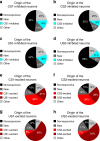Population coding of valence in the basolateral amygdala
- PMID: 30518754
- PMCID: PMC6281657
- DOI: 10.1038/s41467-018-07679-9
Population coding of valence in the basolateral amygdala
Abstract
The basolateral amygdala (BLA) plays important roles in associative learning, by representing conditioned stimuli (CSs) and unconditioned stimuli (USs), and by forming associations between CSs and USs. However, how such associations are formed and updated remains unclear. Here we show that associative learning driven by reward and punishment profoundly alters BLA population responses, reducing noise correlations and transforming the representations of CSs to resemble the valence-specific representations of USs. This transformation is accompanied by the emergence of prevalent inhibitory CS and US responses, and by the plasticity of CS responses in individual BLA neurons. During reversal learning wherein the expected valences are reversed, BLA population CS representations are remapped onto ensembles representing the opposite valences and predict the switching in valence-specific behaviors. Our results reveal how signals predictive of opposing valences in the BLA evolve during learning, and how these signals are updated during reversal learning thereby guiding flexible behaviors.
Conflict of interest statement
The authors declare no competing interests.
Figures








References
Publication types
MeSH terms
Grants and funding
LinkOut - more resources
Full Text Sources

